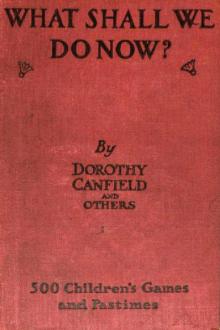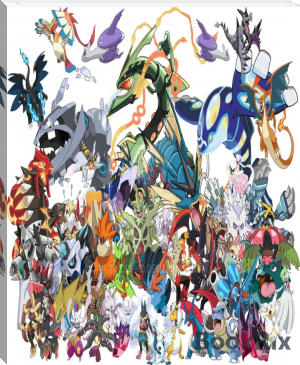What Shall We Do Now? by Dorothy Canfield Fisher (books on motivation .TXT) 📖

- Author: Dorothy Canfield Fisher
- Performer: -
Book online «What Shall We Do Now? by Dorothy Canfield Fisher (books on motivation .TXT) 📖». Author Dorothy Canfield Fisher
Toy dogs are fairly intelligent, but noisy and wayward. They cannot be recommended as interesting pets, since they have little originality; but they can be taught tricks, and if treated sensibly and not pampered, no doubt they would develop more intelligence. The best of the toy dogs are Pugs, toy Pomeranians, the King Charles' Spaniel (black and tan in color), and the Blenheim spaniel (white and chestnut).
The PomeranianThe Pomeranian is a sharp and rather snappy dog, not remarkable for either great intelligence or amiability; but, as with all breeds, there are individual exceptions to this rule.
PoodlesPoodles are intelligent and the best of all dogs for learning tricks. They are also very expensive.
MongrelsMongrels can be the best of friends. They are often more original and enterprising than their too highly-bred cousins, and they are very self-reliant; but as a rule they are not so courageous nor so steadfast as a well-bred dog. The chief advantage of possessing a mongrel is that dog-stealers are less likely to be tempted by him, and you can give him more freedom, which will make him more interesting and intelligent than a dog you need to shut up and look after carefully.
CatsThere is very little to say about cats, except that they need much petting and plenty of milk and tit-bits. They should always have a warm bed in a basket or chair. They should never be allowed to stay out-of-doors at night.
Wild RabbitsOf all rabbits the brightest and most intelligent, as a pet, is the wild rabbit. If you can get two or three baby wild rabbits and feed them on milk, they will grow up very tame. We heard recently of two small wild rabbits that were taken out of the nest and brought up by hand. They and their mistress and a collie pup would play together, and they ran about the room, racing over the floor and furniture. In the summer one escaped from the coop on the lawn in which they were shut up, so the other was turned loose too. They would both come out of the bushes when called, run about over one's dress, and hunt pockets for oats or bits of apple, and would still play with their old friend the collie. It is sad to tell of their death, which they met at the jaws of a strange dog who came marauding. They did not recognize in him an enemy, and easily fell his victims.
Tame RabbitsThe long-haired Angora variety of rabbit is intelligent and very handsome. These need regular grooming and great care, or their long coat gets matted and frowsy. Belgian hares are big, powerful animals, rather apt to be uncertain in temper, but they have beautiful glossy coats and are enterprising and amusing. The lop-eared rabbit is a stately beast and less brisk than his prick-eared relations. The Himalayan rabbit has no connection with the mountain chain from which it has its name, is white, with all its extremities—nose, ears, tail, and feet—black or very dark in color. The Dutch rabbits are small. The body is colored, but the neck, forelegs, and jaws are white. But to the ordinary owner of a rabbit in a hutch, particular variety does not matter very much.
Rabbits' HutchesA good hutch can be made of a grocer's box, by covering the open front partly with bars or wire netting and making a door. The hutch should stand on legs, or at any rate should be raised from the ground, and holes should be bored in the bottom for drainage. Then put in clean straw, and it is ready for the rabbit. In cold or wet weather and at night, it is well to throw a cloth over the hutch for warmth. The hutch must be well ventilated, and it should be made in two compartments, one to admit plenty of light, and the other dark. It should be made so that the animal may be confined in either compartment while the other is cleaned out.
Food and ExerciseBran, grain, and vegetables—such as peas, parsley, carrots, turnip-tops, but not much cabbage—serve for rabbits' food. It is advisable to vary it occasionally. The leaves should not be wet, but a dish of clean water may always stand in the hutch.
The animal should be allowed at least half an hour's run every day, precautions being taken against its burrowing habits, and against its finding anything poisonous to eat. More than one family should not be allowed out at the same time, as they are very pugnacious. Most diseases are the result of neglect in cleaning out the hutch regularly and thoroughly. Rabbits which most nearly approach the wild in color are hardiest.
Teaching RabbitsIf you find you have an intelligent rabbit who quickly learns to come to you when you call him by name, you will find, with patience, you can teach him that when you say "On trust," he must not touch the dainty you offer him, and that "Paid for" means he may have it. He will also learn to "die," and shake hands when you tell him to do so.
Guinea-PigsGuinea-pigs need treatment and housing similar to rabbits.
SquirrelsIn buying a squirrel make sure it is a young one, because whereas a young one is difficult enough to tame, an old one is not to be tamed at all. Unless you can give him a really large cage, with room for a branch on which he may leap about, it is cruel to keep a squirrel at all, so beautifully free is his nature. A little side compartment containing a revolving wheel should be added. Your only chance of taming him is to be extremely quiet and gentle in all your visits to the cage and in giving him his food—nuts, acorns, grain, cold boiled potatoes, dry bread, and now and then a small piece of cooked meat. A very charming account of what it is possible to do with tame squirrels will be found in a little book called Billy and Hans, by Mr. W. J. Stillman.
MiceMice should have a cage with two compartments, one of which should have a door in the woodwork but no wires. In this room should be a bed of hay. The natural food of mice is grain, but in captivity they are generally fed on bread and milk and slices of apple. They can be tamed to a small extent, but for the most part they do no more than run round a wheel, although if other gymnastic contrivances are offered them they will probably do something with them. Dormice (to whose food you may add nuts) sleep through the winter months, and are therefore not very interesting for more than half the year.
TurtlesA turtle is rather an interesting animal to keep, although he will not do much in return. Even in summer they have a curious way of disappearing for weeks together, and in winter, of course, you see nothing of them. An ordinary mud turtle is often seen moving slowly along the roads after a rain. He can be carried home by turning him over on his back—but be careful to keep your fingers away from his snapping mouth. As a rule they can feed themselves, and they also have the happy knack of doing without food altogether for long periods, so that you need not be anxious.
FishBowls of goldfish are not uncommon, but few people seem to care for fish of other kinds. And yet a little aquarium can be stocked for a small sum and is a most interesting possession. One small tank of young bream, for example, can be a perpetual and continually fresh delight. Let the tank have cloisters of rockwork and jungles of weed, so that hiding may be possible, and then watch the smaller fish at their frolics. Young trout are hardly less beautiful, and very easy to keep healthy, in spite of general opinion to the contrary. The important thing is to maintain a current of water through the tank. The old way was to carry the overflow down a pipe in the centre through its surface opening, but an improvement on this system is for the leakage to be at the bottom of the tank and the inflow at the top. Young perch are beautiful too,—and tench, and dace, and roach,—and all are hardy. Feeding them is very simple. The shop from which you buy the fish will keep you supplied with the proper food. The American catfish, with its curious antennæ or whiskers, and its gleaming eyes, set as by a jeweler, is more wonderful, and not a whit more difficult to keep. But to be amused by such unfamiliar neighbors as a tankful of fish there is no real need either to stray abroad or to spend any money. The ordinary minnow, which you can catch in any stream and pop into a jar, will serve to introduce you to a new world—a world of silent progressions, of incredible celerities, of amazing respirations.
SilkwormsSilkworms, if kept at all, ought to be taken seriously and used for their true purpose. That is to say, you really ought to wind their silk carefully. Few owners of silkworms in this country seem to trouble to do this. Silkworms' eggs can be bought of any naturalist, or some one who keeps silkworms will willingly give you some. The time is about the end of April. They are usually laid on scraps of paper, and these you put in shallow paper and cardboard trays covered with gauze, and place them in the room where the sun can reach them. As the worms hatch out you must move them—it is done best with a small paint brush—to another tray or trays and keep them supplied with fresh mulberry leaves or lettuce. The worms continue to grow for about a month, and then, when full-sized, they prepare to spin. You may know that this time is reached by their refusal to eat, and you must then make a little paper toilet, about two inches deep, for each worm, and drop it in. You have now nothing to do (except to watch the worms regularly) for some weeks, in which time the cocoon has been finished and the worm has become a chrysalis. When the chrysalis inside the cocoon rattles the time has come to wind the silk, or the moth will shortly emerge and eat it. The outside of the cocoon is useless and can be removed by placing the cocoon in warm water. Once that is out of the way, the silk can be wound on a card. The moth soon afterward appears and, after growing to its full size, lays its eggs—some two hundred—and dies. It must be remembered that with silkworms a little practical demonstration from any one who has kept them is worth much more than many pages of hints. One thing is of the highest importance, and that is constant attention. Silkworms must never be neglected.
Other CaterpillarsSilkworms are more useful but not more interesting than many other caterpillars which can be hatched from eggs. The Privet Hawk Moth, for example, is very easily bred, and a very beautiful creature it is when in full plumage. But for information on this subject you must go to more scientific books.
PigeonsPigeons are not exactly pets, for they rarely do more than come to you for their food, just as chickens do, but they are





Comments (0)